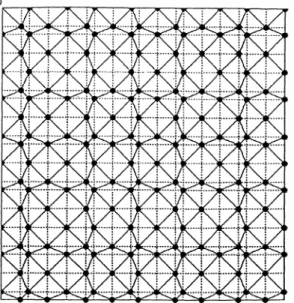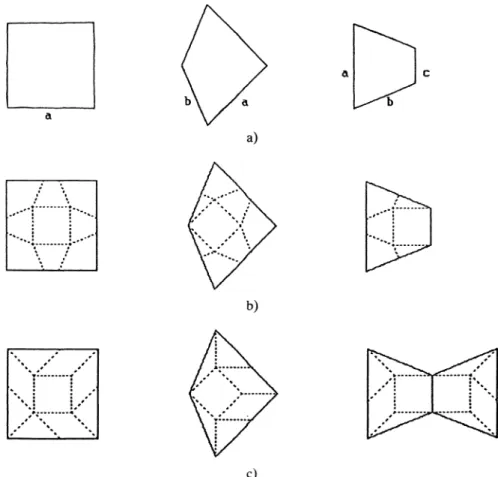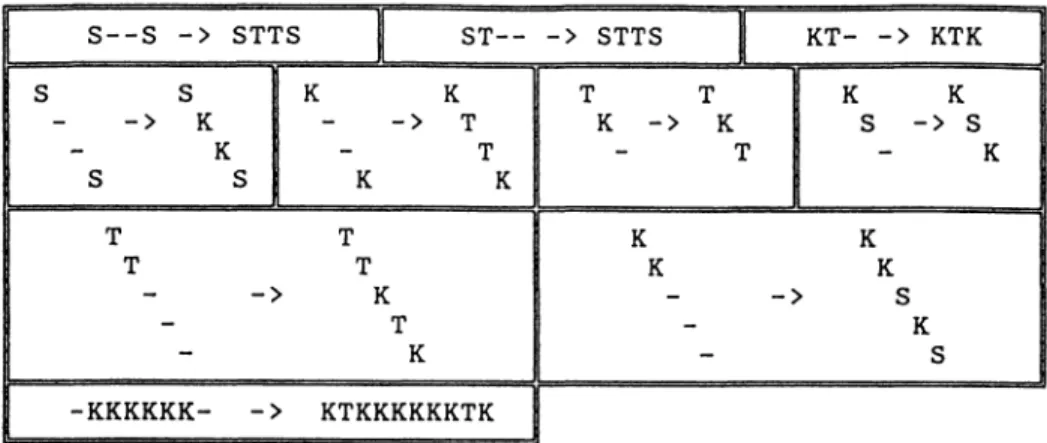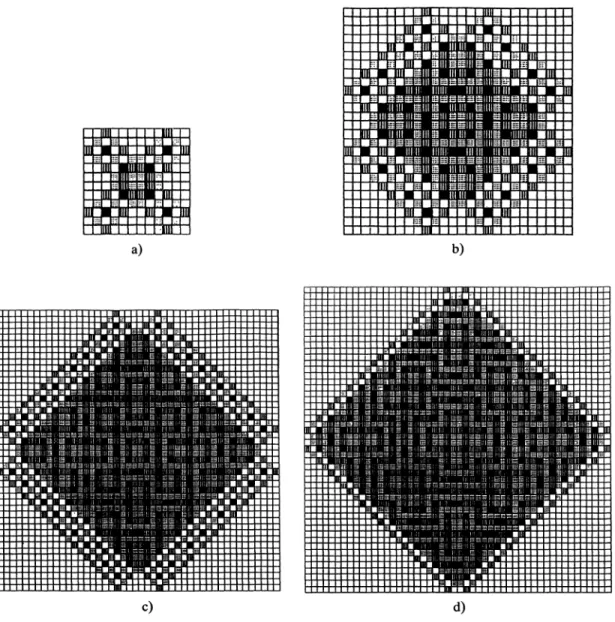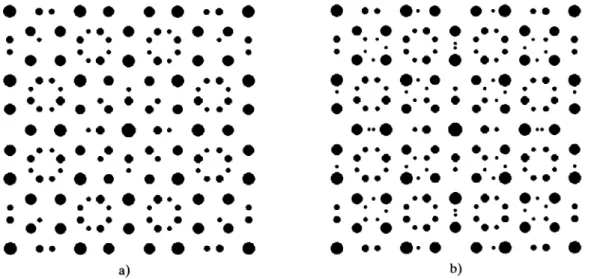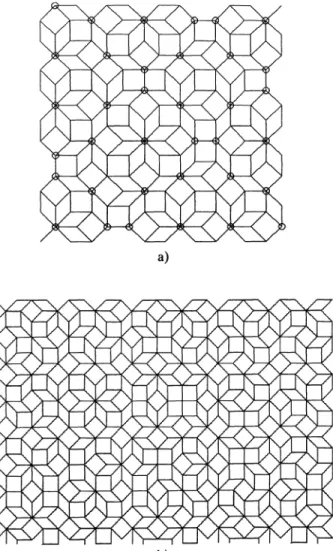HAL Id: hal-02382037
https://hal.archives-ouvertes.fr/hal-02382037
Submitted on 27 Nov 2019
HAL is a multi-disciplinary open access
archive for the deposit and dissemination of
sci-entific research documents, whether they are
pub-lished or not. The documents may come from
teaching and research institutions in France or
abroad, or from public or private research centers.
L’archive ouverte pluridisciplinaire HAL, est
destinée au dépôt et à la diffusion de documents
scientifiques de niveau recherche, publiés ou non,
émanant des établissements d’enseignement et de
recherche français ou étrangers, des laboratoires
publics ou privés.
Geometric study of a 2D tiling related to the octagonal
quasiperiodic tiling
Clément Sire, Rémy Mosseri, Jean-François Sadoc
To cite this version:
Clément Sire, Rémy Mosseri, Jean-François Sadoc. Geometric study of a 2D tiling related to the
octagonal quasiperiodic tiling. Journal de Physique IV Proceedings, EDP Sciences, 1989, 50 (24),
pp.3463-3476. �10.1051/jphys:0198900500240346300�. �hal-02382037�
Cl´
ement Sire, R´
emy Mosseri, Jean-Fran¸cois Sadoc. Geometric study of a 2D tiling related
to the octagonal quasiperiodic tiling.
Journal de Physique, 1989, 50 (24), pp.3463-3476.
<10.1051/jphys:0198900500240346300>. <jpa-00211156>
HAL Id: jpa-00211156
https://hal.archives-ouvertes.fr/jpa-00211156
Submitted on 1 Jan 1989
HAL is a multi-disciplinary open access
archive for the deposit and dissemination of
sci-entific research documents, whether they are
pub-lished or not.
The documents may come from
teaching and research institutions in France or
abroad, or from public or private research centers.
L’archive ouverte pluridisciplinaire HAL, est
destin´
ee au d´
epˆ
ot et `
a la diffusion de documents
scientifiques de niveau recherche, publi´
es ou non,
´
emanant des ´
etablissements d’enseignement et de
recherche fran¸
cais ou ´
etrangers, des laboratoires
publics ou priv´
es.
Geometric
study
of
a2D
tiling
related
to
the
octagonal
quasiperiodic tiling
Clément Sire
(1),
Rémy
Mosseri(1)
andJean-François
Sadoc(2)
(1)
Laboratoire dePhysique
des Solides de Bellevue,C.N.R.S.,
1place
Aristide Briand, 92195Meudon, France
(2)
Laboratoire dePhysique
des Solides, Université Paris-Sud, 91405Orsay,
France(Reçu
le 31 mai 1989, révisé le 19juillet
1989,accepté
le 6septembre
1989)
Résumé. 2014
Au moyen de trois tuiles, nous construisons un pavage
quasipériodique
duplan,
quenous relions au
quasicristal
octogonal.
Ainsi, nous montrons que les coordonnées des n0153udspeuvent être obtenues de deux manières différentes. Le facteur de structure est calculé
exactement. Ce pavage
qui
possède
« presque » unesymétrie
d’ordre huit, soulève la difficulté de la déterminationpratique
de lasymétrie
d’unquasicristal.
Finalement, nous montrons commentconstruire une
large
classe de pavage du type del’octogonal,
àpartir
de ce nouveau pavage.Abstract. 2014 A
quasicrystal
built with three types of tiles is related to the well-knownoctagonal
tiling.
Therelationships
between bothtilings
areinvestigated.
Moreprecisely,
we show that the coordinates of the vertices can be obtained in two different butequivalent
ways. The structurefactor is calculated
exactly.
Weemphazise
thedifficulty
one can have to define the order of thesymmetry of a
quasicrystal,
from apractical point
of view,exhibiting
aquasiperiodic
tiling
whosespectrum has a «
quasi »
eigth-fold
symmetry.Finally,
we show how to recovereasily
a class ofoctagonal-like
quasicrystals.
Classification
Physics
Abstracts 61.50E1. Introduction.
Since the
discovery
ofalloys
withquasiperiodic
structureby
Shechtman et al.[1],
many careshave been devoted in the
experimental
domain,
to the determination of atomicpositions.
This is aprerequisite
to a betterunderstanding
ofphysical properties.
At thetheory
level,
aparallel
effort has been done with many new resultsconcerning
thegeometry
of thequasiperiodic
structures and their diffractionpatterns.
Concerning
thephysical properties,
however,
the field is still in itsinfancy.
This ismainly
due to the lack ofappropriate
tools,
theanalogues
forinstance,
of Bloch sums, or Brillouin zones ofcrystal physics. Only
in onedimension do we have a rather
precise
knowledge
of thequasicrystal
excitationspectrum.
This iswhy
we foundinteresting
to look to extensions tohigher
dimensions of these 1 Dquasicrystals.
In the case of the 1D structure related to the irrational number 1 +B/2,
we havediscovered a more
interesting tiling,
the «labyrinth
», which is a subset of order two of the euclidianproduct.
As will be shownbelow,
thelabyrinth
is veryclosely
related to the standardoctagonal
[5,
6] quasiperiodic
tiling.
However,
it is muchsimpler
to many respects. Forexample,
its coordinates can begiven
explicitely,
which is a non trivialproperty
forquasiperiodic
tilings
of dimensiongreater
than 1. Thistiling
has a verysimple
averagelattice,
and their mutual
correspondence
is derived in astraightforward
way from theexpression
of the site coordinates.2. The recursive method.
We shall consider a sequence of letters A and B
describing
the alternation ofsegments
of twodifferent
lengths.
Let us callSe
the sequence obtainedaccording
to thefollowing
rule :where * is a
symbol
forstring
concatenation. This sequence is of the same kind as the well-known Fibonacci sequence studied in a very exhaustive wayby
many authors. This sequence,which we shall call the « Octonacci » sequence, is related to 4Y = 1 +
J2
in thefollowing
way : ifFl
is defined as thelength of Se
thenFl obeys
the same recursion formula asSe
withFo
=F
= 1.
Then,
it is easy to see thatFe + 1 IFi --+ 0
wheni --* + oo.
Moreover,
Se +
1 can be obtainedfrom Se
by applying
thefollowing
rule due to theself-similarity
ofS
.It is well-known that
S.
is norperiodic
neither random butquasiperiodic.
Then,
a sequenceof
arbitrarily length
inSoo
can be found an infinite number of times.Now,
afterhaving
associated alength
f A
to an A and alength
f B
to eachB,
let us define the«
labyrinth » tiling by
selecting
among the set ofpoints
of the Euclidianproduct
Se
xSe,
those sites which can be linked to theirneighboring
sitesby
apath
of non vertical norhorizontal
bonds,
starting
the process at theorigin
(Fig. 1).
Moreprecisely,
we see that thistiling
consists of half the wholeproduct
set.Finally,
if wejoin
the nearestneighbors by
Fig.
1. -The
labyrinth
is obtainedstarting
from the euclidianproduct Sp
xSe
(dotted lines)
by linking
points
withdiagonal
bonds.«
diagonal »
bonds,
we obtain atiling
of onequarter
of theplane.
In order to obtain atiling
ofthe whole
plane,
we tile the three otherquarters
in the same way as the first one. The infinitetiling
we obtain is of coursequasiperiodic
and consists in theassembly
of threeelementary
tiles whose exactshapes depend
on the ratio r =f A/fB.
Wealways
obtain asquare, a
trapezoid
and a kite whose sides aregiven
onfigure
2. If we colour eachelementary
tile in adifferent way, the reason for
calling
thistiling,
the «labyrinth
», becomes manifest. We showon
figure
3 thelabyrinth
for r «-- 1 and r :::> 1. We can even consider the limit caser =
1,
and obtain aquasiperiodically
coloured square latticeressemling
alabyrinth
(Fig. 3).
If we follow one of thosepaths,
we can see that it can bearbitrarily long.
Indeed,
sinceSOC)
is self-similar weexpect
the« labyrinth »
to be self-similar too. We found inflation-deflation rules for thisquasiperiodic
tiling
which we have summarized infigure
2 Theshapes
of the inflated tiles are the same as those of theoriginal tiling
if andonly
if r = 1 +-.J2 =
0.It is
possible
to do the sameprocedure starting
with the Fibonacci sequence or any othersequence not related to 4l. Note that the two 1D
quasicrystals,
are notnecessarily
the same,neither at
right angle.
In this paper, we focushowever,
on the structure based on the Octonacci sequence, and first describe another construction of thelabyrinth.
Fig.
2. -(a)
Thelabyrinth
is made of threeelementary
tiles : a s uare, a kite, and atrapezoid.
Thelengths a, b,
c, arerespectively equal
to#,
F
and#.
Here we tookr =
f AI f B
= 1 +h.
(b)
Deflation rules for thelabyrinth.
(c)
The decorations of the three tilesleading
3. Another dérivation of the
labyrinth.
The
labyrinth
structure appears verysimply
out of a new construction ofquasiperiodic tilings
[2],
derived from the cut andproject
method[4].
This method is rathergeneral
but we shall focus on theoctagonal tiling
case. Vertices of thehypercubic
latticeZ4
are selected andmapped
onto a 2Dphysical
spaceE,
whenever theirprojection
onto the 2D space E’(orthogonal
toE)
falls inside a window W. The window is the convex hull of theprojection
onto E’ of the standard
hypercube
ofZ4.
Now,
let us viewZ4
as a stratified structure : a 2D square lattice(the base)
of 2D square lattices(the fibres),
associated to eachpoint
of the base.The
acceptance
region
can be drawn on each fibre as theprojection, parallel
toE,
of the unithypercube.
Theoctagonal tiling
vertices can then be selected. Theprocedure
can be donedirectly
on Eby mapping
theseacceptance
regions,
one for each fibre. Theprojection
onto E of the basegives
a square lattice B. Theacceptance
regions
areregular
octogons
O lm,
centered on a sublattice of order 4 of B. To eachpoint B l+m,
thecorresponding
afm
is centered on the line from theorigine
toBem,
at twice the distance. Each fibreprojects
onto E as another square lattice
Fe, m,
identical toB,
but rotatedby
7T /4.
The vertices areselected as follows. To each
point Bem,
one attaches a square latticeFe,m,
from which weselect those vertices which fall inside the
octogon
Oem.
Anoctagonal tiling
is thus recovered. Butinstead,
if in eachoctogon
oneonly keeps
the vertex of F closest to theaem
center, whichwe call
Qem,
then,
thelabyrinth
is obtained. The coordinates can beeasily
obtained. Let usderive them in the B-basis with unit
edge.
We haveLet A be the rotation matrix
by
ir/4
So,
the lattice F is obtainedby applying
A to each vertex of B. In the Fbasis,
thepoint
Bem
has coordinatesgiven by
A -
1 (Bem).
In order to attach a F lattice toBlm,
one should shiftit
by
a vectorSem
where frac
(x )
is the fractionalpart
of the coordinates of x. In the shifted Fbasis,
thepoint
Qem
has coordinatesequal
toA -l(Qem) -
Sem.
Thepoint
of the shifted F closest toQem
iswhere
F (x )
is the closestinteger
to x. In theB-basis,
the coordinates areThis can be written
These above relations form what is called
explicit
coordinates for thetiling
vertices. It is a oneto one relation between a
couple
ofintegers
(f, m)
which takes allpossible
values,
and thecorresponding pair
of real coordinates. This is not the case fortilings generated by
the standard cut andproject
method. In that case, the vertex coordinates can be written as alinear combination
(with
integer coefficients)
of a set of n « star » vectors. But among allpossible n-uplets, only
a few arekept
after a selectionprocedure
in theorthogonal
space. It isprecisely
thisalgorithmic
step
(the
most timeconsuming)
which isbypassed
whenexplicit
coordinates aregiven.
Now,
consider a nonperiodic
array ofpoints.
It is said to possess an average(periodic)
lattice if there exists a one-to-one relation between the former
points
and the latticepoints,
and if their distance remains bounded. With thisdefinition,
thelabyrinth
has an averagesquare
lattice,
theacceptance
region
lattice,
which shows upsimply by replacing
F (x )
by
anidentity
operator.
This is notsurprising
since theoctagonal
tiling
itself was foundto have an average lattice
[3].
Thisquestion
of nonperiodic tilings having
or not an averagelattice is a difficult one and is in fact two fold. First is the existence
problem.
Asurprising
result comes from thestudy
of 1Dtilings
generated
by
the circle map[7].
As a consequence of a theoremby
Kesten,
it is found that for alarge
class of suchtilings,
the fluctuation of the sitecoordinates from their average
position
(the
lattice definedby
thedensity)
is unbounded.Other
results,
in the context of the cut andproject
method,
have been obtained[8]
which show that it is a subtlequestion.
The secondpoint
is,
whenever an average latticeexists,
tofind the
explicit
one-to-one relation. In the case of theoctogonal
tiling,
this is a difficult task. In thepresent
labyrinth
case, both the existence and theexplicit
relation can be verysimply
read from the above
expressions.
From the morephysical point
of view,
it may beargued
thatviewing
aquasicrystal
as asuitably
distortedcrystal
can open new field ofinvestigations.
Asan indication among
others,
theHume-Rothery
type
ofarguments
toexplain
their relativestability
[9]
can then be studied. Forexample
in1D,
it has been shown that the Fibonaccichain
might
be stabilized withrespect
to theperiodic
chain for some electron densities[10].
4. Proof of the
equivalence
of the two methods.In the
following,
we show that thepreceding
definition of thelabyrinth
isequivalent
to theone
given
in section 2. Let us defineWe notice
that p and q
have the sameparity.
Therefore,
it isequivalent
to define thelabyrinth
by
thepoints
whose coordinates areand
With this new definition and since
Up - Up - e
takesonly
two values 1/2 and 1/2 + a, in order to show that both definitions areequivalent,
weonly
need to prove that the sequence of 0 and1 defined
by
where
Re(p)
is thep th
term of the sequence oflength Fe,
isequal
to Se
with thecorrespondence
First of
all,
we define a sequence of rationalapproximants
for a,
pe/qe f
E N. pp and q pverify
thefollowing
recursion formulassince all the terms in the continued fraction
representing a
areequal
to 2. The firststep
of theproof
consists inshowing
that for 5 smallenough,
F(qpe/qe
+5)
=F(qpe/qe).
For anyintegers p
and q, and for 9 = ±1,
we have 2 qpf -(2 p + 0 )
qe =1= 0,
since forany f,
it is easyThis last
inequality
shows thatsince
Now,
using
this lastresult,
it becomes easy to see thatF (aq )
=F (qpf , 21qf -, 2) for
anyq = 1, ... , q P + 2 by recalling
that,
according
to the definitionof pe + 2
and qf , 2, we have1 a -
pe+ 21qi , 21
-1 lqe
+ 2 qf+ 3 . We can therefore rewrite
We deduce that
Re (q)
=Re (qf , 2 - q
+1 )
andthus,
thatRl
issymmetric.
SinceRl + 2
isbeginning
in the same way asRl + 1
we have shown thatwhere
Wl
is a sequence oflength qe
=Fe.
We end thisproof by showing
thatWQ
=Rl.
For q
=1, 2,
..., ql we have to show that
This is a consequence of the first lemma we
proved
in thebeginning
of this section and thefollowing
property
verifiedby
pp/qe :
where we used the fact that
and
Moreover,
sinceRo
=So, R1
=S,
andRp
and Se obey
the same recursion formula we concludethat
they
areequal,
andthus,
that both definitions for the coordinates of the vertices of thelabyrinth
arecompletely equivalent.
Let us show now, two other ways to build the
labyrinth.
The first one consists instarting
from an
octagonal
quasicrystal.
But instead ofapplying
the process described in section3,
wetake as the vertices of the
labyrinth,
the vertices of theoctagonal
tiling, plus
some newpoints
choosen in the
following
way. Each horizontal square of theoctagonal
tiling
is surrounded atleast
by
tworhombi,
and forms anhexagon
with them. We add a vertex and two bonds in each suchhexagon, symmetric
to thealready existing
vertex andbonds,
withrespect
to the centerof the
hexagon.
In theoctagonal tiling,
eachhexagon
contains one vertex taken from a« flipping pair
», theflipping occuring
under an infinitesimal shift of the band inZ4
(in
the cut andproject
method[4] language).
Then,
in theoctagonal
tiling,
weonly
keep
vertical and horizontal
bonds,
put
bonds on the shorterdiagonal
of the thinrhombi,
and linktogether
two vertices in the samehexagon.
The «labyrinth »
is then obtained.We found the last way to build the
labyrinth
in ourattempt
to find localgrowth
rules forit,
i. e. some rulesallowing
one twoput
a tile of thelabyrinth, knowing
the tiles in a circle of finite constant radius around it. Even if thelabyrinth
cannot be builtby
means of localgrowth
rules,
we can construct it with some local rules andonly
one non local rule. Let us start from four kites.Then,
enumerating
thepossible
localarrangements
in thelabyrinth,
deduced from theproperties
of the Octonacci sequence, we found the local rules showed infigure
4. We write K for akite,
S for a square and T for atrapezoid,
and build thelabyrinth
forr =
1,
even if those rules are correct for any r(with
few modifications since the three tiles arethen
différent).
They
have to be read in thefollowing
way : if we find one of thearrangements
quoted
infigure
4(or
thisarrangement
rotatedby
amultiple
of’TT’ /2),
addletter(s)
according
to the rule
corresponding
to thisarrangement.
Theprocedure
has to be carried out until it isno
longer possible
toput any other tile.
Then,
weapply
theonly
non local rule needed : weadd one tile on the closest free
place
to the xand y
axes, and to theorigin.
There areeight
such
points.
The tile is the same for thosepoints,
and is choosen in order that the sequence oflarge
and short bonds between groups of four kitesalong
the x axis followsSoo
(because
of theself-similarity
of thelabyrinth).
We show the first iterations of this method infigure
5. Ofcourse, instead of
applying
this non localrule,
we can decide toput
a tile on a random freeplace,
preserving
the four-foldsymmetry
or not.Then,
we obtain alabyrinth-like
quasiper-iodic
tiling.
In that case, somearrangements
appear that cannot be found in thereal labyrinth
(Fig. 5).
Moreover,
in the random case, andwhen r =A 1,
there are somedefects,
since the K and the T are not squares anylonger.
Fig.
4. - Local rules for thelabyrinth
on a square lattice(r
=1 ). « »
represents a free
place,
« K » akite, « T » a
trapezoid,
and « S » a square.5.
Reciprocal
space.In this section we are interested in the
k-space
of thelabyrinth
andespecially
to itssymmetries.
A well-known resultconcerning
quasicrystals
like thequasiperiodic
octagonal
tiling,
is that theirspectrum
is dense.Moreover,
in a boundedpart
of thereciprocal
space, and for any7o >
0,
one can findonly
a finite number ofpeaks
whoseintensity
exceedIo.
Thus,
experimentally,
for realquasicrystal,
one canonly
observe apoint
spectrum
whosesymmetries give
us some informations about the structure into the real space.We show below
that,even
if thelabyrinth
hasonly
a true four-foldsymmetry,
it would have been very difficult todistinguish
«experimentally »
itsspectrum
from thespectrum
of theoctagonal tiling,
which has aeight-fold
symmetry.
Let us nowproceed
to the calculation of thespectrum
of thelabyrinth.
We showed in sections 2 and 3 that thepoints
of thelabyrinth
areFig.
5. -(a)-(c)
The first iterations of theprocedure
described in section 4.(d)
Anexample,
where thenon local rule has been
replaced by
a random choice.(With
thecorrespondence,
square = black,kite =
grey and
trapezoid
=stripes).
located at the nodes of the
product
of two Octonacci linear chains whose coordinates have thesame
parity.
Thus,
we defineI (q)
andJ(q),
the Fourier transforms of both chainsWith this
normalization,
theintensity
of thepeak
at k = 0 isequal
to 1. We now derive theexact form of I
(q )
andJ(q ),
by
the mean of the cut andproject
method[4],
whicheasily
leadsto the
spectrum.
From the form ofUp
we see thatSi
can be obtainedby
theprojection
of thepoints
ofZ2 belonging
to astrip
ofslope 0
obtainedby
the translation of the unit square on aline of the same
slope.
Furthermore,
sinceUp
= -U-,,
we deduce that the center of the unit square must be on vertex of the square lattice for the chain to besymmetric.
In order toevaluate
I(q) (and J(q )) ,
we sum the contributions ofpoints,
which are theprojections
ofvertices in
Z2
whose coordinates have the sameparity
(respectively,
of theopposite
parity).
Astraightforward
calculationgives
the intensities of thepeaks
of both even and odd chains :and
where H = 7r
(cos (0)
+ sin( 0 »,
and 0 is definedby
tan( 0 )
= 0. Now we can deduce theintensity
of the diffractionpeaks
of thelabyrinth
W (k) =
|S (k ) | 2
by
using
(5)
and(6).
Itgives
the diffractionpattern
offigure
6. At firstsight,
it seems to have theeight-fold
symmetry.
We show in thefollowing
that it is not true,by studying
thespectrum
on the two axeskz
= 0 andkl = k2,
for which the calculations arequite
easy.
First,
we show thefollowing
result : if k =(k, 0)
is in thespectrum,
then k’ =(k/
J2,
k/
-N,/2-)
which is the vector krotated
by
ir/4,
is also in thespectrum. Indeed,
if k =(k, 0)
is in thespectrum
of thelabyrinth,
then it is easy to show that theintegers m
and n in(6)
must be even.Thus, k
can bewritten k = m cos
(0)
+ n sin(0)
and we have toverify
thatk/
J2
can be written in the same way as in(6).
It is a consequence of theequality
Fig.
6. -Diffraction pattern of the
labyrinth.
The area of a spot isproportional
to the square ofS (k ).
We haveonly
consideredpeaks
whoseintensity
were greater thanIo,
with the convention that theintensity
at k = 0 isequal
to 1. ForIo,
we have taken,(a)
Io
= 0.06,(b)
Moreover,
thisproperty
is notonly
true for k on the xaxis,
but for every k in thespectrum,
what can be seenby
a calculation of the same kind as above. The strict four-foldsymmetry
of the Fourierspectrum
wasexpected
since in the cut andproject
method,
thelabyrinth
acceptance
region
is a square tangent to theoctagonal region corresponding
to theoctagonal
tiling
[11].
We have to notice that it canhappen
that thepeak
at k’vanishes,
it thephase
in the sine in(6)
is amultiple
of 2 7T. We find that it occurs when k is of the form k =2 n (cos ( 0
+ sin( e ) ) = n (4 + 2
h)
where n is aninteger.
But for those values ofk,
we shall see that theintensity
in k isonly
4.7/n 2
percent
of theintensity
atk = 0. This
property
of invarianceby
a rotation ofir/4
(even
if the intensities are not thesame)
is sharedby
thequasiperiodic
tilings
built from an Octonacci like sequence but no othersequence. For
example,
the 2Dquasicrystal
built with the Fibonacci sequence does not show the sameproperty.
Being
theproduct
of two linearchains,
itsspectrum
has of course thefour-fold
symmetry. But,
if k is in thespectrum,
then the vector k rotatedby
-U/4
neverbelongs
toit.
Now,
going
back to thelabyrinth,
we can compare the two intensities at k and k’. Let usdefine
where we define pk = n cos
( 0 ) -
m sin( 9 )
for k = mcos ( 0 )
+ n cos( 0 ) -
If we look forRmax
the absolute maximumof
| R (k) |
|
we findSo,
the maximumdisagreement
between bothspectra
arises for the valuewhere
W (k ) ---
0.047 andW (k’ )
= 0. This value is easy to understand : since thelabyrinth
isobtained
by adding
vertices to theoctagonal quasiperiodic tiling
weexpect
itsspectrum
toressemble that of the
octagonal tiling.
Moreprecisely
weexpect
the maximumdisagreement
to be about the square of the number of
points
we add per « atom » of theoctagonal tilling,
that is
(1 /2 - 1 / B/2-)2 -.
0.043,
which isquite
close to the valueeffectively
obtained. Moreover if theintensity
W(k)
isquite large
thenW (k’ )
will be very close toW(k).
Thisexplains
the« quasi » eight-fold
symmetry
of thelabyrinth.
Forexample,
for k = cos(0)
+ 3 sin(0),
we haveW(k) --
0.748 andW(k’);.--
0.751,
and for k = cos(0)
+ 2 sin(0),
we findW (k ) .-
0.8667 andW (k’ )
= 0.8674. If we do the samestudy
with k not on the x
axis,
we obtain very similar results(compare
Figs.
6a andb).
Thus,
in this section we have shown anexplicit example
of aquasiperiodic
tiling,
whosespectrum
seems at firstsight
to have theeight-fold
symmetry,
withouthaving
itperfectly.
Furthermore,
the «experimental
»spectrum
of thelabyrinth
would have been said to have theeight-fold
symmetry,
if the resolution were at best 5 %. This raises thequestion
of whether or not it isreally possible
tospecify
at theexperimental
level,
the realsymmetries
ofa
quasicrystal.
Theproblems
encountered at the moment, to propose icosahedralquasiper-iodic structures which fit
exactly
theexperimental
diffractionpatterns,
areperhaps
linked tothe
problem developed
in this section. Can we find modelizedquasicrystals
which have notthe
icosahedral _
symmetry,
but whosespectrum
fits theexperimental
patterns
at the accuracydescription
of theexperimental aperiodic phases,
either asquasicrystals,
orcrystals
withlarge
unit cell.
Indeed,
while in that case the diffractionspectrum
sit at differentpoints
(even
veryclose),
in our case, the locations ofpoints
are the same,only
do the intensitiesslightly
vary.6.
Recovering
theoctogonal
quasicrystal.
Now,
we show the way to recover theoctagonal quasiperiodic tiling
from thelabyrinth
whereas,
in section3,
we have shown how to build thelabyrinth
from the standardoctagonal
quasiperiodic
tiling.
If we look for thepossible
decorations of each tile of thelabyrinth
(Fig. 7),
weonly
find one decoration for the kite and the square, and twopossible
decorations for thetrapezoid,
which arealways coupled
(Fig. 2).
Moreover, since the square
can have fourorientations,
we have to show that thedegrees
of freedom due to the twopossible
decorations of thetrapezoid,
and the fourpossible
orientations of the square areonly
apparent.
In order to recover theoctagonal
tiling,
we first decorate every kite of thelabyrinth
in the way shown in
figure
2. We havealready
noted that everypath
of kites is closed. At eachFig.
7. -(a)
Thelabyrinth
as obtainedby
the method of section 3.(b)
Anoctogonal-like
quasiperiodic
tiling generated by
means of the randomprocedure
described in section 6.corner of those
paths,
there isonly
one way to decorate a square.Following
thepath
of kitesthere is
only
one way to decorate thetrapezoid
after the square. The nexttrapezoid
is choosensymmetric
to the last one.Then,
there isonly
one way to decorate the next square withrespect
to the decorations of the lasttrapezoid
and the border of kiteexcept
if the square issurrounded
by
fourtrapezoids.
In that case we have to wait until we know the decoration of atrapezoid
perpendicular
to the direction of thetrapezoid preceding
the square, that wealready
know. We carry on the process until we find another corner, and so on.Thus,
we findonly
one way to decorate the squares andtrapezoids
between two closedpaths
of kites in order to obtain theoctagonal
tiling.
However,
if we do not want to recover the exactoctagonal tiling,
butonly
aquasicrystal
built with the same two tiles(the
square and therhombus),
we canapply
thefollowing
rules.Starting
from thelabytinth,
remove one of the vertices of the shortest side of eachtrapezoid,
and link theremaining points
with bonds of thesame
length
as the square side in thelabyrinth.
One can choose thepoint
to remove,randomly
or with any other rules. Forexample,
among the twopoints,
for agiven trapezoid,
we can remove the left-hand vertex, for horizontalbonds,
and the bottom vertex, for vertical bonds. In the random case weexpect
the diffractionpattern
to have aeight-fold
symmetry,
whereas in the second case the
spectrum
hasonly
a four foldsymmetry.
Moreover,
ingeneral,
we obtaintilings
with certain localconfigurations
that cannot be found in the realoctagonal
tiling
(Fig. 7).
7. Conclusion.
In this paper, we have studied the
geometric properties
of a newquasiperiodic tiling,
the«
labyrinth
»,closely
related to the well-knownoctagonal tiling.
We showed a recursive wayto build the
labyrinth,
andthen,
gaveexplicit
coordinates for its vertices. Thelabyrinth
has anaverage
lattice,
which is a square lattice. It is self-similar but cannot be builtby
means of localgrowth
rules.Moreover,
its diffractionpattern
exhibits aninteresting
property.
Although
ithas
strictly speaking, only
the four-foldsymmetry,
itsspectrum
has «nearly
» theeight-fold
symmetry.
Consequently,
it would have been very difficult to make the difference«
experimentally »
(if
we have not known itsspectrum
analytically).
In a
forthcoming
paper, the excitation spectrum of thelabyrinth,
which possesses veryinteresting properties,
will bepresented
[12].
Acknowledgements.
We are indebted to M. Duneau and C.
Oguey
forstimulating
conversations.References
[1]
SHECHTMAN I., BLECH I., GRATIAS D., CAHN J. W.,Phys.
Rev. Lett. 53(1984)
1951.[2]
SADOC J. F. and MOSSERI R., to bepublished
in J.Phys.
France.[3]
DUNEAU M. and OGUEY C., NumberTheory
andPhysics,
LesHouches,
March 1989(Springer),
tobe
published.
[4]
DUNEAU M. and KATZ A.,Phys.
Rev. Lett. 54(1985) ;
KALUGIN P. A., Yu KITAEV A. and LEVITOV L. S., Pis’ma Zh.
